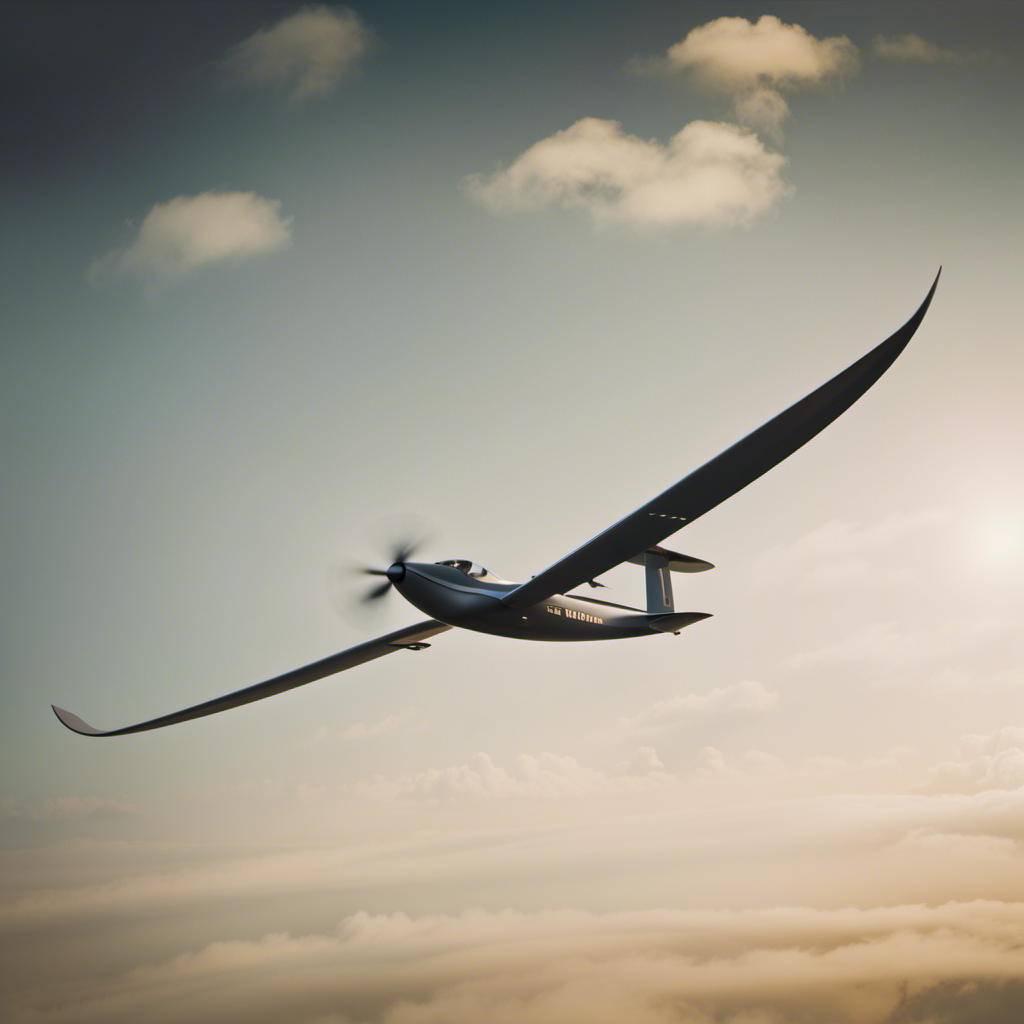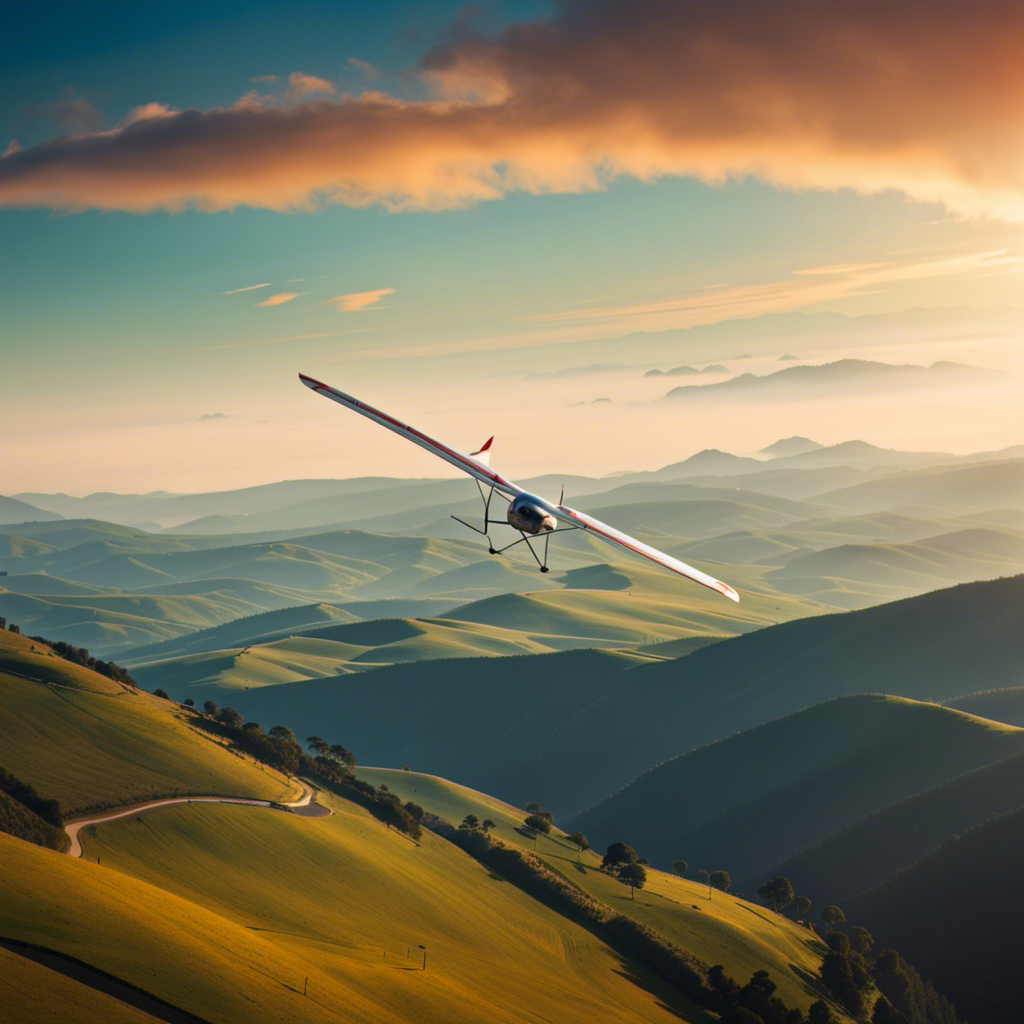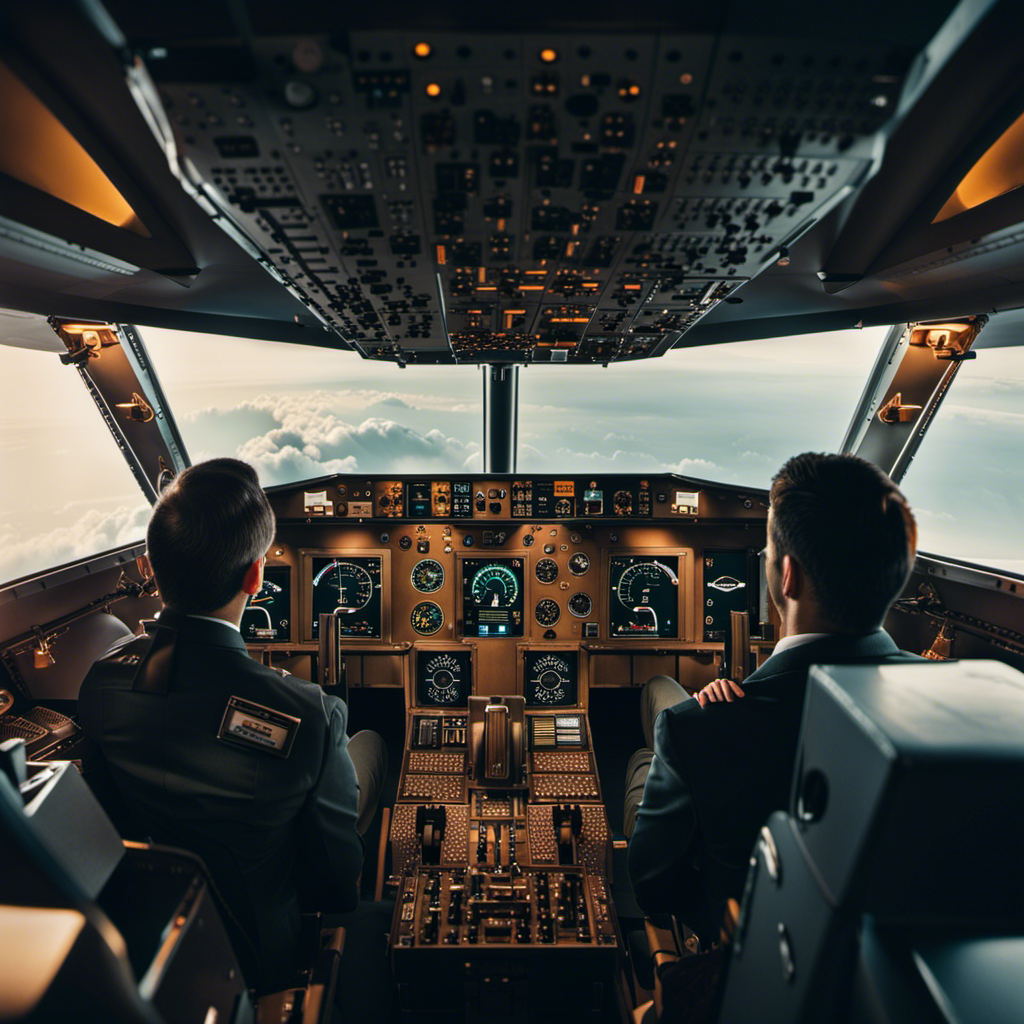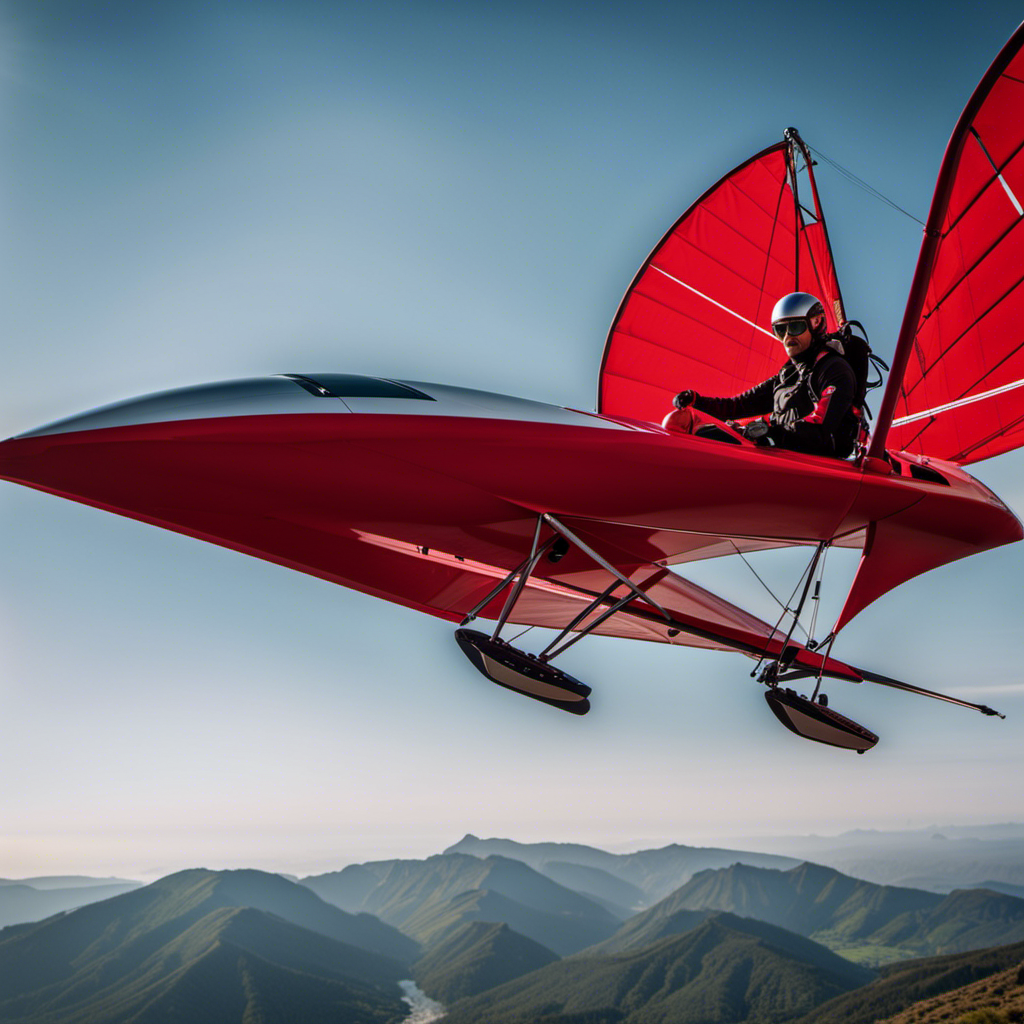As someone who flies gliders, I am often amazed by the almost magical ability these sleek aircraft have to stay in the air, effortlessly defying gravity with grace and precision.
But the truth is, there’s no magic involved. It all comes down to the delicate balance between lift and gravity, the mastery of airfoils, and the art of harnessing thermals and updrafts.
In this article, we will explore the intricacies of glider design and the science behind what keeps these magnificent birds soaring high above the Earth.
Key Takeaways
- The shape of the wings, specifically their curved upper surface and flatter lower surface, generates lift to counteract gravity.
- Thermals and updrafts provide additional lift for gliders, and skillful maneuvering within them allows the glider to gain altitude.
- Glider performance and efficiency can be improved by optimizing the glide ratio, reducing drag, and increasing wing efficiency.
- Safety measures, regular maintenance, and proper training are essential for glider pilots to ensure safe and successful flights.
The Basics of Glider Design
The wings of a glider are specifically designed to generate lift and keep the aircraft in the air. Glider structure plays a crucial role in achieving this. The wings are typically long and slender, with a high aspect ratio, meaning the wings are long and narrow. This design helps in reducing drag, allowing the glider to maintain a sustained flight. The wing construction also ensures that the glider is lightweight, enabling it to stay airborne with the help of rising air currents.
Aerodynamics is another key factor in glider design. The shape of the wings and the overall structure of the glider are carefully optimized to minimize drag and maximize lift. The wings are often curved on the top surface and flatter on the bottom, creating a pressure difference that generates lift. This lift force opposes the gravitational force acting on the glider, keeping it airborne.
Transitioning into the role of lift and gravity, the careful design of the glider’s wings and structure allows it to harness the power of lift to counteract the force of gravity. By understanding the principles of aerodynamics and utilizing the optimal glider structure, we can explore the fascinating world of gliding flight and experience the thrill of soaring through the sky.
The Role of Lift and Gravity
Lift and gravity work together to keep a glider airborne. Lift is the force that acts perpendicular to the direction of motion and is generated by the shape of the wings. Gravity, on the other hand, is the force that pulls the glider downwards towards the Earth. In order for a glider to stay in the air, the forces of lift and gravity must be balanced.
The role of lift is crucial in keeping a glider airborne. It is created by the difference in air pressure between the top and bottom surfaces of the wings. As the glider moves forward, the air flows faster over the curved top surface of the wings, creating a lower pressure compared to the bottom surface. This pressure difference generates an upward force called lift, which opposes the force of gravity and keeps the glider in the air.
Gravity, on the other hand, is constantly pulling the glider downwards. Without the force of lift, the glider would simply fall to the ground. However, by generating lift through the shape of the wings, the glider is able to counteract the force of gravity and maintain its altitude.
Understanding the role of lift and gravity in keeping a glider airborne is essential for understanding airfoils, which play a crucial role in the design of glider wings.
Understanding Airfoils
Understanding airfoils is essential in comprehending the design of glider wings. Airfoil design is a crucial aspect of aerodynamic principles that enable gliders to stay aloft. An airfoil is a specially shaped wing section that generates lift when air flows over it. It is designed with a curved upper surface and a flatter lower surface. This shape creates a pressure difference between the two surfaces, resulting in lift. The airflow above the airfoil moves faster, creating lower pressure, while the airflow beneath moves slower, creating higher pressure. This pressure difference generates lift, countering the force of gravity and allowing the glider to stay in the air.
The design of the airfoil plays a significant role in determining the glider’s performance. Factors such as the camber, thickness, and angle of attack are carefully considered during the design process. The camber refers to the curvature of the airfoil, which affects lift and drag. The thickness of the airfoil determines its strength and structural integrity. The angle of attack, which is the angle between the airfoil and the oncoming airflow, affects the lift and drag forces acting on the glider.
Understanding airfoil design is just the first step in comprehending the intricate mechanisms that keep gliders airborne. Another crucial aspect is harnessing thermals and updrafts, which provide the glider with additional lift and allow it to stay airborne for extended periods.
Harnessing Thermals and Updrafts
To make the most of thermals and updrafts, you should learn how to identify their presence and utilize them to your advantage. Understanding thermal dynamics and employing effective soaring techniques can greatly enhance your gliding experience.
Thermals are columns of rising air that occur when the sun heats the ground, causing the air above it to rise. These rising columns of warm air can provide a glider with the lift needed to sustain flight. Updrafts, on the other hand, are pockets of rising air that can be found near hills, mountains, or other natural features that disrupt the flow of wind. By recognizing the visual cues and using your instruments, such as variometers and altimeters, you can detect the presence of thermals and updrafts.
Once you’ve identified a thermal or updraft, it’s important to exploit it to maximize your glider’s performance and efficiency. This involves skillfully maneuvering your glider to stay within the rising air column. By circling within the thermal, you can gain altitude, allowing you to stay airborne for longer periods and cover greater distances.
Mastering the art of harnessing thermals and updrafts is crucial for successful gliding. By understanding the thermal dynamics and employing effective soaring techniques, you can make the most of these natural phenomena to enhance your glider’s performance and efficiency.
Transitioning to the next section about glider performance and efficiency, it is important to consider other factors such as wing design and weight distribution.
Glider Performance and Efficiency
When it comes to glider performance and efficiency, one of the key factors to consider is the glide ratio and its importance.
The glide ratio refers to the distance a glider can travel forward compared to the altitude it loses during descent.
A higher glide ratio is desired, as it allows the glider to cover more ground and stay in the air for longer periods.
Improving glide performance can be achieved through both design modifications, such as reducing drag and increasing wing efficiency, as well as by adopting proper techniques, such as optimizing speed and utilizing thermals effectively.
Glide Ratio and its Importance
The glide ratio is a key factor in determining how efficiently a glider can stay in the air. It is a measure of how far the glider can travel horizontally for every unit of altitude it loses.
Glide ratio optimization is crucial for maximizing the glider’s performance and extending its flight time. Several factors affect glide performance, including the shape and design of the glider’s wings, the weight and balance of the aircraft, and the wind conditions.
By understanding these factors and making adjustments, pilots can improve the glide ratio and increase the efficiency of their glider. Improving glide performance through design and technique involves fine-tuning the wing shape, reducing drag, and mastering the art of finding thermals and updrafts.
These strategies allow gliders to stay aloft for longer durations and cover greater distances without relying on an engine.
Improving Glide Performance through Design and Technique
Improving glide performance involves fine-tuning the wing shape, reducing drag, and mastering the art of finding thermals and updrafts. To enhance aerodynamic efficiency, it is crucial to optimize weight distribution. This can be achieved by strategically placing ballast or adjusting the position of the pilot. By reducing excess weight and ensuring proper weight distribution, the glider can achieve better balance and maneuverability. Additionally, fine-tuning the wing shape plays a significant role in improving glide performance. Design modifications such as winglets, airfoil profiles, and wing camber can minimize drag and increase lift, resulting in a smoother and more efficient glide. Lastly, mastering the art of finding thermals and updrafts is essential for sustaining flight and prolonging the glider’s time in the air. This requires a keen understanding of atmospheric conditions, wind patterns, and thermal dynamics. By effectively utilizing these techniques, pilots can optimize their glide performance and maximize their flight time.
| Techniques to Improve Glide Performance |
|---|
| Optimize weight distribution |
| Fine-tune wing shape |
| Master the art of finding thermals |
| Minimize drag |
| Enhance aerodynamic efficiency |
Transitioning to controlling the glider in flight, precise control inputs are crucial to maintain stability and execute maneuvers effectively.
Controlling the Glider in Flight
Controlling a glider in flight is achieved by adjusting the position of the control surfaces. These surfaces include the ailerons, elevator, and rudder, which are responsible for controlling the roll, pitch, and yaw of the glider respectively. By manipulating these control surfaces, pilots are able to maneuver the glider and maintain control throughout the flight.
To effectively control a glider, pilots must employ various techniques and principles of aerodynamics. Here are five key factors to consider:
-
Center of gravity: Properly positioning the center of gravity is crucial for maintaining stability and control. Adjustments can be made by shifting ballast or redistributing weight within the glider.
-
Control inputs: Pilots use precise control inputs to manipulate the control surfaces and achieve desired maneuvers. These inputs must be smooth and coordinated to avoid inducing unnecessary drag or instability.
-
Trim settings: Adjusting the trim settings allows pilots to relieve control pressures and maintain a desired attitude during steady flight. This reduces pilot workload and improves overall efficiency.
-
Flight envelope: Understanding the glider’s limitations and operating within its specified flight envelope is essential for safe and effective control. Exceeding these limits can lead to loss of control or structural failure.
-
Pilot skill and experience: A pilot’s proficiency in controlling a glider greatly influences the overall flight performance. Ongoing training and experience help pilots develop the necessary skills to handle various flight conditions.
By mastering these controlling techniques and understanding the underlying aerodynamics principles, pilots can safely navigate the skies while optimizing the glider’s performance.
Now, let’s explore the important safety measures and emergency procedures that every glider pilot should be aware of.
Safety Measures and Emergency Procedures
To ensure safe operations, it’s important for glider pilots to be familiar with and follow proper safety measures and emergency procedures. Safety training plays a crucial role in preparing pilots for any potential risks or emergencies that may arise during flight. As a glider pilot, I have undergone extensive safety training to ensure I am equipped with the necessary knowledge and skills to handle various situations.
One of the key aspects of safety training is learning about emergency landings. In the event of an engine failure or any other unforeseen circumstance, pilots must be able to quickly and safely land the glider. This involves identifying suitable landing areas, assessing wind conditions, and executing a controlled descent.
Emergency procedures also cover other potential hazards such as inclement weather, bird strikes, or mid-air collisions. Pilots must be able to react swiftly and effectively, following established protocols to mitigate risks and ensure the safety of both themselves and others.
By being well-versed in safety measures and emergency procedures, glider pilots can confidently navigate the skies and handle any unforeseen challenges that may arise.
In the next section, we will explore the importance of glider maintenance and care, which plays a vital role in ensuring the continued safe operation of these aircraft.
Glider Maintenance and Care
When it comes to maintaining and caring for gliders, two key points that require attention are regular inspections and repairs, as well as the proper storage and protection of the gliders.
Regular inspections are crucial in identifying any potential issues or damage that may affect the performance of the glider. This includes checking the structural integrity, control systems, and avionics.
Additionally, proper storage and protection are essential in preserving the condition of the gliders, ensuring they are ready for flight whenever needed. This includes protecting them from weather elements, such as rain and extreme temperatures, as well as using covers and secure storage facilities to prevent any damage.
Regular Inspections and Repairs
You should regularly inspect and repair your glider to ensure it stays in the air safely. Inspections are crucial for identifying any potential issues or damage that could compromise the glider’s performance. By conducting thorough inspections, you can catch problems early on and prevent them from escalating into more serious issues. Repairs, on the other hand, are necessary to fix any damages or worn-out components. This ensures that the glider remains structurally sound and functions optimally. To help you keep track of your glider’s maintenance, here is a table outlining the key areas to inspect and common repairs that may be required:
| Area to Inspect | Common Repairs |
|---|---|
| Wings | Patching small tears, replacing damaged ribs |
| Control Surfaces | Repairing loose hinges, replacing worn cables |
| Fuselage | Fixing cracks or dents, reinforcing weak areas |
| Landing Gear | Replacing worn tires, tightening loose bolts |
Regular inspections and repairs are essential for maintaining the safety and performance of your glider. Now, let’s move on to discussing the storage and protection of gliders without further ado.
Storage and Protection of Gliders
Storing and protecting gliders is crucial for maintaining their condition and prolonging their lifespan. To ensure the safety and longevity of gliders, here are some essential storage solutions and weather protection measures:
-
Hangar: Gliders should be stored in a dedicated hangar to protect them from the elements and potential damage.
-
Covers: Using high-quality covers shields gliders from dust, moisture, and UV rays, preventing corrosion and deterioration.
-
Climate Control: Maintaining a stable temperature and humidity level in the storage area helps prevent warping and other structural damage.
-
Security: Implementing proper security measures, such as surveillance systems and access control, prevents theft and vandalism.
-
Regular Inspections: Conducting routine inspections of stored gliders allows for early detection of any issues and timely repairs.
The Thrill of Glider Flying
Experiencing the thrill of glider flying is like nothing else you’ve ever felt. The rush of soaring through the air, completely at the mercy of the elements, is both exhilarating and awe-inspiring.
Glider competitions take this excitement to another level, pushing pilots to their limits and showcasing the artistry and skill involved in flying without an engine.
To succeed in glider competitions, mastering the various soaring techniques is crucial. These techniques include finding and utilizing thermals, which are columns of rising air created by the sun heating the Earth’s surface. By circling within a thermal, glider pilots can gain altitude and stay airborne for extended periods of time.
Another technique is ridge soaring, where pilots fly along a ridge or mountain slope to take advantage of the updrafts created by the wind hitting the terrain.
As I anticipate the future of gliding, I imagine even more advanced technology being incorporated into gliders, allowing for better efficiency and increased performance. Additionally, I believe that the sport will continue to grow in popularity, attracting more pilots and spectators alike.
The thrill of glider flying is truly unmatched, and I can’t wait to see where the future takes us.
The Future of Gliding
As a glider pilot, I’m fascinated by the advancements in glider technology that have been made in recent years.
These advancements have allowed gliders to reach higher altitudes, fly longer distances, and perform more intricate maneuvers.
Not only do these advancements enhance the performance and safety of gliders, but they also have significant environmental benefits.
Gliders produce zero emissions and require no fossil fuels to fly.
Advancements in Glider Technology
You’ll be amazed at the advancements in glider technology. As we look towards the future of gliding, engineers and designers are constantly pushing the boundaries to enhance efficiency, safety, and performance.
Here are some key advancements that are shaping the future of gliding:
-
Improved materials: The use of carbon fiber composites and other lightweight materials has significantly reduced the weight of gliders, allowing for greater maneuverability and increased glide ratios.
-
Aerodynamic design: Streamlined shapes, optimized wing profiles, and innovative wingtip devices, such as winglets or airfoils, are being employed to reduce drag and improve lift-to-drag ratios.
-
Avionics and instrumentation: Gliders are now equipped with advanced navigation systems, weather radars, and computerized flight control systems, enhancing safety and providing pilots with real-time information for improved decision-making.
These advancements in glider technology are revolutionizing the sport and paving the way for a more sustainable future of aviation. As we delve into the environmental benefits of gliding, we discover how this form of flight minimizes carbon emissions and reduces our ecological footprint.
Environmental Benefits of Gliding
The environmental benefits of gliding extend beyond reduced carbon emissions and a smaller ecological footprint. Gliding, as a form of sustainable aviation, has a minimal environmental impact compared to traditional powered flight. The absence of an engine means gliders do not emit any pollutants or noise during flight. This reduction in emissions contributes to cleaner air and a healthier environment.
Furthermore, gliders operate on renewable energy sources such as wind and thermals, making them highly sustainable. The low energy consumption and efficient aerodynamics of gliders also contribute to their minimal environmental impact.
Frequently Asked Questions
What are the different types of gliders and their respective advantages and disadvantages?
There are several types of gliders, including wood, fiberglass, and carbon fiber. Wood gliders are affordable but heavy, while fiberglass and carbon fiber gliders are lighter but more expensive.
How do glider pilots navigate and find thermals during a flight?
Glider pilots use various techniques to navigate and find thermals during a flight. They rely on their knowledge of wind patterns, cloud formations, and terrain features to identify areas of lift and maximize their time in the air.
Are there any specific weight limitations for glider passengers?
Weight limits for glider passengers are set by safety regulations. These limits ensure that the glider remains within its maximum weight capacity, allowing for safe and efficient flight operations.
What are the main factors that affect a glider’s performance and efficiency?
Glider aerodynamics and lift mechanics are the main factors that affect a glider’s performance and efficiency. By manipulating the shape of the wings and controlling airflow, we can optimize lift and reduce drag, allowing for longer and more efficient flights.
What are some common safety precautions that glider pilots should take before and during a flight?
Before and during a flight, glider pilots should adhere to several safety precautions. These include conducting thorough pre-flight checks to ensure the aircraft is in optimal condition and following proper procedures for takeoff, landing, and emergency situations.
Conclusion
In conclusion, glider flying is an exhilarating and intricate sport that relies on a combination of aerodynamic principles and skillful piloting. With a wingspan of up to 20 meters and a glide ratio of 1:40, gliders are capable of reaching impressive heights and distances.
Did you know that the world record for the longest glider flight is 1,502.9 kilometers? This statistic showcases the incredible potential and endurance of gliders, making it a truly awe-inspiring activity for aviation enthusiasts.
So, strap in and experience the sheer thrill of soaring through the skies in a glider!
Orion, better known as “Jetstream,” is the voice that brings the stories of the skies to life. His fascination with aviation began at a young age, sparked by his father’s tales of flying and adventure. Orion’s journey into the world of gliding was serendipitous, and from the moment he took his first glider flight, he knew he had found his calling.










